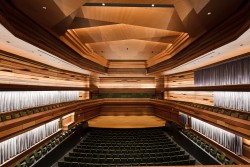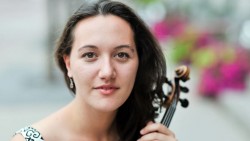
One was Jeanne Lamon, first and recently retired director of Tafelmusik Baroque Orchestra, for whom Tafelmusik’s recently renovated concert hall at the Trinity-St.Paul’s Centre in Toronto is named. The other was Isabel Overton Bader, for whom Queen’s University’s Isabel Bader Centre for the Performing Arts in Kingston is named and without whom (along with husband Alfred Bader), the Centre and its stunning 566-seat recital hall would almost certainly never have come into existence.
Lamon took a bow onstage at the Isabel last Saturday night as one member of a distinguished 10-person jury (along with fellow violin virtuosi Martin Beaver, Jonathan Crow and Barry Shiffman) for the inaugural Isabel Overton Bader Canadian Violin Competition, which kicked off on Wednesday April 26 with a two-day semifinal round during which the field was winnowed down from seven to three violinists. Friday was an intensive rehearsal day with the competition’s two indefatigable collaborative pianists, Benjamin Smith and Michel Szczesniak, for the three finalists: Toronto-based Katya Poplyansky, Vancouver’s Lucy Wang and Yolanda Bruno from Ottawa.
Saturday’s final round consisted of three separate short solo recitals (at 6pm, 7pm and 8pm, respectively) with order of appearance drawn by lot, and roughly 15-minute breaks in between. As with the semifinal round, which was a very clever blend of compulsory and optional elements, the final round was deftly structured to allow both for clear points of comparison and for artistic self-expression.
To explain: each of the seven semifinalists was required, ahead of the competition, to choose the first movement of one of the five Mozart violin concerti to open their final program, should they make it to the finals. (For the detail-driven among you, each of the five, except Concerto No. 2, was chosen by at least one competitor, and, as it turned out, two of the three finalists, including the winner, chose to prepare No.3 in G Major.) What made the exercise particularly intriguing from an audience perspective, though (and I expect particularly revealing for the jurors), was that each performer was also required to perform her own original cadenza for the chosen concerto. It also gave each violinist the opportunity to establish a rapport with the pianist playing the reduction of the orchestral score, and to hear themselves in the hall.
After that appetizer, the main course of each program was a complete violin concerto, again with piano reduction, of the performer’s own choosing, and it was here that the personalities of the individual players shone through. Katya Poplyansky (who had chosen Mozart Concerto No.4 in D Major to start her program), followed it with the Prokofiev Violin Concerto in D Major, Op.63. Lucy Wang, who followed, chose Dvořák’s Violin Concerto in A minor, Op. 53.
 To round the evening off, Yolanda Bruno, the eventual $20,000 first prize winner (and winner of the audience choice prize), took on Bartók’s Violin Concerto No 2, BB 117 with Benjamin Smith as pianist. It should be said that the competition was open to Canadian violinists from 18 to 29 years of age, and that while age is not necessarily an indicator of musical maturity it was clear from the first downstroke of the violin in the Mozart that Bruno has at this stage in her career achieved a level of comfort in her own musical skin that enabled her to fully relish the moment, interpretively and collaboratively. She and pianist Smith played off each other in the Bartók to an astonishing extent, evoking the full orchestral scope and scale of the work. The fact that Bruno currently performs on the 1700 Taft Strad on loan from the Canada Council for the Arts Musical Instrument Bank probably had something to do with it. So too did Smith’s extraordinary feathering of the pedals of the hall’s first-rate Steinway piano.
To round the evening off, Yolanda Bruno, the eventual $20,000 first prize winner (and winner of the audience choice prize), took on Bartók’s Violin Concerto No 2, BB 117 with Benjamin Smith as pianist. It should be said that the competition was open to Canadian violinists from 18 to 29 years of age, and that while age is not necessarily an indicator of musical maturity it was clear from the first downstroke of the violin in the Mozart that Bruno has at this stage in her career achieved a level of comfort in her own musical skin that enabled her to fully relish the moment, interpretively and collaboratively. She and pianist Smith played off each other in the Bartók to an astonishing extent, evoking the full orchestral scope and scale of the work. The fact that Bruno currently performs on the 1700 Taft Strad on loan from the Canada Council for the Arts Musical Instrument Bank probably had something to do with it. So too did Smith’s extraordinary feathering of the pedals of the hall’s first-rate Steinway piano.
But the hall itself, and the kind of listening it evokes from its audiences – a kind of collective responsibility for the acoustical occasion – is in and of itself something unique in the Canadian musical landscape. It’s a facility that will, if well curated, and supported in its programming with the same sense of responsibility as went into the acoustical perfecting of the place, become one of those places that chamber musicians, and others, seek out, for the pleasure of the opportunity to simply be their best.
Tricia Baldwin is executive director of The Isabel Bader Centre, wooed back to Kingston from Tafelmusik, where she was general manager during Jeanne Lamon’s heyday. As for the future of this particular competition, she tells me, the plan is for it to continue as a triennial affair (like its illustrious counterparts, the Honens Piano Competition in Calgary and the Banff International String Quartet Competition). “But don’t expect solo violin to be its defining characteristic,” she says. “More central is the idea that it is a competition for young Canadian musicians.”
However that idea plays out, it’s off to a flying start.
David Perlman can be reached at publisher@thewholenote.com.



